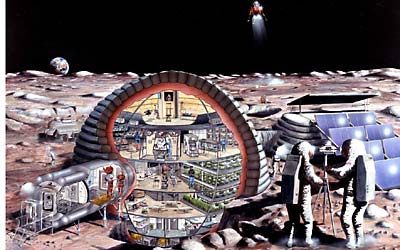How important is the Moon?by Taylor Dinerman
|
| What is not often said is that the moon is a critical, so called “Gibraltar point”, in the Earth-Moon system. |
The Outer Space Treaty, of course, prohibits any signatory from building such a base and there is no sign that it will be abolished any time in the foreseeable future. Treaties and international agreements are inherently fragile things. History shows they only exist as long as powerful nations are willing to follow them. Idealists who believe that these kinds of agreements can substitute for military and economic power are not only often disappointed, but can sometimes take those who follow them down with them.
In his 1999 book, “The Avoidable War,” J Kenneth Brody shows how the British peace movement helped paralyze British power at a critical moment when Hitler could have been stopped as he reoccupied the Rhineland, overturned Europe’s security structure, and set in motion the logic that would lead toward World War Two. In spite of a lot of overheated rhetoric, no one comparable to Hitler is leading any of today’s world powers. That, however is no reason not to imagine that in the future the world will not be a far nastier place that it is now.
This brings us to back to the Moon and to its relationship with American spacepower. American spacepower, like British 19th century seapower, has military, commercial, scientific, and “colonial” aspects. Building a base or a colony on the Moon will enhance America’s non-military spacepower. For this reason alone it would be a good thing to do from a national security standpoint. Even more important, it will provide America with a foothold that, if needed, can be transformed into a real military base in an emergency.
| Building a new home for humanity on the Moon is in the national interest in the same way that building the Panama Canal or carrying out the Marshall Plan was. |
The Chinese are thinking about such a base and no doubt believe that they will find it militarily useful to have such a base. It would be a mistake to try and build a single international moonbase, similar to the ISS. Instead a number of moonbases that will probably be built that will provide for a level of mutual support and will, under normal circumstances, be open to visitors. However benign the stated reasons for building these bases, though, they are major national assets.
This Administration has often tried (with mixed success) to integrate its efforts so that its actions in one area, say energy, support its efforts in another, say Middle East policy. There is nothing new or particularly original about this, but they do seem to push this concept more intensively than their predecessors did. A drive to build a sustainable lunar base would support their plans to secure American supremacy in the Earth/ Moon system, to keep America at the forefront of science and technology, to inspire and educate a new generation of highly trained scientists and engineers, to diversify America’s sources of energy and minerals and to show the world that this nation still has the pioneering spirit. As Ronald Reagan said that Americans “have every right to dream great dreams.” Building a new home for humanity on the Moon is such a great dream. It is in the national interest in the same way that building the Panama Canal or carrying out the Marshall Plan was. In the most profound way, such a project would be in America’s enlightened self-interest.
